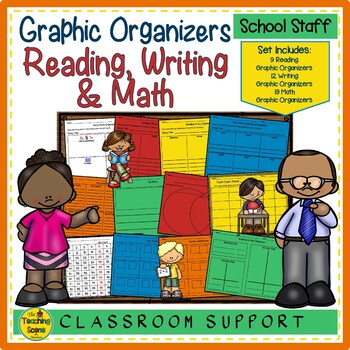Graphic Organizers: Reading, Writing and Math Charts and Graphs
- PDF
Description
Are you looking for some ready-made graphic organizers for your students? This resource may be for just what you are looking for. These Classroom Graphic Organizers can be used for your reading, writing, and math curricular activities. Have students organize classroom data using these easy to use graphic organizers!
Resource Prep: Graphic Organizers can be copied with regular copy paper for as many students as needed. Some may be copied on cardstock and laminated to be able to use over and over.
Resource Includes the Following :
✎ Reading Graphic Organizers (9 versions)
✎ Writing Graphic Organizers (12 versions)
✎ Math Graphic Organizers (19 versions)
Resource Description:
Reading Graphic Organizers: Story Parts Organizer (2 types): After reading a story, have students fill out the story elements: characters, setting, problem & ending., either by drawing or writing out with words.
Retelling Story Organizer (2 types): After reading a story, have students fill out the story parts organizer, naming the beginning, middle and ending of the story.
Sequencing Story Organizer (3 types): After reading a story, have students fill out the sequence story retelling. Students must sequence the events in the story in order.
5 W’s and How Story Organizer (2 types): After reading a story, have students fill out the 5 W’s & How questions of the story.
Writing Graphic Organizers: My Writing Topics: This organizer can be filled out by students at the beginning of the year to give them a variety of topics to write about during writing time.
My Dictionary My Story (2 types): Students use this organizer to add words that they use in their writing pieces. It can be kept in their writing folder so they can use and add to it as they do their writing pieces.
My Story (2 types): Students can use this organizer for story writing. There are two types for younger and older lower elementary students.
Journal Entry (2 types): This organizer can be used for daily or weekly journal entries. You can make multiple copies and staple in booklet form for students to use.
Venn Diagram: After reading or discussing two topics students fill out this organizer to compare and contrast the two topics.
Nonfiction Writing Chart Organizer: After reading factual book students fill this organizer out to write a nonfiction piece. They must include a topic and concluding sentences and at the bottom of the sheet students write out their facts and conclusion into sentences to make a paragraph. This paragraph can be typed up to make a classroom book or a student display. Extra sheets available in case students need more room.
Acrostic Poem Organizer (3 types): Students write words that begin with each of the letters of a topic work to complete the poem.
Math Graphic Organizers: 100 Chart (3 types): A colored chart with a number to 100, a colored chart with numbers and number line and a blank sheet for students to write their numbers are available. The colored charts can be copied on card stock and laminated for students to use all year long.
110 Chart (3 types): A colored chart with a number to 110, a colored chart with numbers and number line and a blank sheet for students to write their numbers are available. The colored charts can be copied on card stock and laminated for students to use all year long.
Dice Addition & Subtraction Organizer: This organizer can be used when students use two dice to practice addition and subtraction math facts. They just write the numbers or place the number of dots they roll and then answer the number sentence.
Dice 3 in a Row Addition Organizer: This organizer can be used when students use three dice to practice 3 addend addition. They just write the numbers or place the number of dots they roll and then answer the number sentence.
Domino Addition & Subtraction Organizer: This organizer can be used when students use two dominoes to practice addition and subtraction math facts. They just write the numbers or place the number of dots they have on their dominoes and then answer the number sentence.
How Much Money Organizer: Students can use this organizer when practicing counting money. Students write down the amount of each coin in the circle and then add them together.
Math Data Charts (6 types): These charts can be used when collecting and comparing data. There are charts for the collecting and comparisons of two, three, and four items.
Graphing in the Classroom (Real Graph Data, Picture Graph, Symbolic Graph): This graph can be used when students are graphing their data in different forms. An example graph is available in this resource.
These graphic organizers help students organize information and data that corresponds to their lesson and can be used as a teacher assessment tool.
✤ Please check out the preview for this product.
✤ Be sure to follow my store to be alerted of new products. CLICK HERE!
✤ Don’t forget to leave feedback. You will receive TPT credits that can be used on your future purchases!
Related Products
✎ Classroom & Behavior Management Set
✎ Classroom Awards & Postcards
✎ Classroom Forms, Notes & Awards for Lower Elementary
✎ First Grade Assessment & Data Forms With Editable Versions





